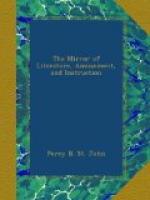of the world is the training of the horses, or the
dexterity of the horseman, equal to the performance
of such exploits. Effigies made of skin and filled
with wind, and others made of straw, in which are live
birds, are placed in the arena. The bull tosses
them in the air, but being made heavy at the base,
they come to the ground always retaining an upright
posture. The straw figures are furnished with
fire-works, which are made to take fire when the birds
escape from within, and it sometimes happens that
the bull has the flaming and cracking figure upon
his horns. Sometimes the bull is maddened by fire-works
being fastened on him, which go off in succession.
The crackers being expended, the animal usually stands
gazing around with rolling tongue, panting sides,
and eyes sparkling with rage. He is then faced
by the principal matador, who holds a straight sword
in one hand and a flag in the other; as the bull runs
at him with full speed, the matador coolly, but with
great celerity, takes one step to the left, holding
the flag just over the spot he occupied when the bull
took aim. Being foiled, the bull wheels round,
and charges his tormentor a second time, who again
skilfully eludes being caught on the horns: this
is repeated about three times, to the great delight
of the audience. At length the matador assumes
a sort of fencing attitude, and at the critical moment,
plunges his sword into the bull’s neck, near
to its shoulders, when it falls dead at his feet.
Handkerchiefs are waved, and applauding shouts resound
from every side. Four horses richly harnessed
then appear. The dead bull is quickly fixed to
traces, and dragged out at a gallop, cheered by continued
acclamations.
“Four steeds that spurn the rein,
as swift as shy,
Hurl the dark bulk along, scarce seen
in dashing by.”
BYRON.
Other bulls are killed in the same way by successive
matadores. One is generally despatched by means
of a long knife grasped by the matador, so that when
his arm is extended, the blade is perpendicular to
the wrist. The bull being worried for a time,
the matador, instead of receiving him on the point
of a sword as before, steps one pace aside as the bull
runs at him, and adroitly plunges the knife into the
spinal marrow behind the horns, and the animal drops
dead instantaneously. Another bull is next attacked
by mounted picadores, armed with lances. Their
legs are protected by padding. Their horses are
of little value, and cannot easily get out of the
way of the bull. Neither do the riders often
attempt it; to do so being considered cowardly.
The consequence is, the horses generally receive a
mortal gore; part of their entrails are frequently
torn out, and exhibit a most disgusting spectacle.
The riders run considerable risk, for their lances
are inadequate to killing the bull, which after being
gored and mangled, is finally despatched by a matador.




